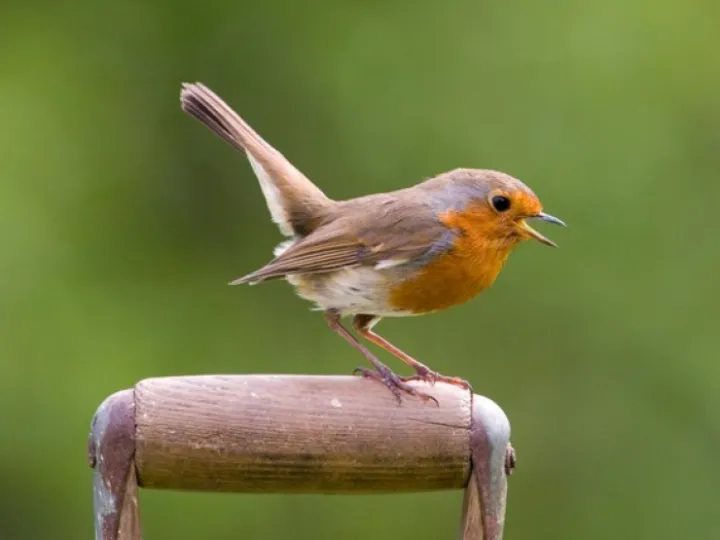Tarvin Birds: The Robin






Birds in Tarvin Woodlands and Gardens
The Robin-also known as the European Robin(Erithacus rubecula)
The Robin (or the Robin Redbreast, as it was at one time widely known) is an exceedingly common bird. It might seem surprising, therefore, that it is amongst the most (if not actually the most) popular bird in Great Britain. It has earned this position through a combination of its appearance, its habits and a vast amount of folk lore which has become attached to this charming little songbird.
It is a small bird, about 5" in length. and both males and females are similar in their colouration, although their breast is not red: it is orange. They have a face lined with grey, upper-parts that are brown and a belly which is whitish. The distinctive orange breast of both sexes contributed to the European robin's original name of "redbreast", orange as the name of a colour was unknown in English until the fruit of the same name had been introduced during the 16th century. It was earlier than that – sometime in the 15th century – when it became popular to give human names to familiar species and the bird came to be known as robin redbreast, which was thereafter shortened to robin (with Robin as a given name being a diminutive form of Robert). Our robins are largely resident all year round but a small minority, usually female, migrate to southern Europe during winter, with a few going as far as Spain. At the same time, Scandinavian and Russian robins will also migrate to Britain and western Europe to escape the harsher winters. These migrants can be recognised by the greyer tone of the upper parts of their bodies and their duller orange breast.
The robin is diurnal (It moves about and feeds during the daytime), although it has been known to hunt insects on moonlit nights or near artificial light at night. The robin in Britain is considered to be a gardener's friend and here our British robins readily associate with gardeners, while elsewhere in Europe they are shy and retiring birds found in thick woodland cover. This may be because continental robins (the migratory northern populations of which winter around the Mediterranean) have long been exposed to hunting in the southern part of their range, leaving the species particularly skulking in its habits, while in Britain we do not share the tradition of trapping and shooting small birds. But why are other British birds less confiding and apparently less-friendly to humans? This may be linked to the robin's feeding behaviour. Robins take most of their food from the ground and this will include the invertebrates which might have been disturbed by larger animals. Perhaps they view us in a similar way, as they scavenge the worms unearthed by the gardener's spade and their behaviour will persist because they know that they have nothing to fear.
Male robins are known for their extremely aggressive territorial behaviour, when they will fiercely attack other males and competitors that stray into their territories. They have been seen attacking other small birds without apparent provocation and there are instances of robins attacking their own reflection! Territorial disputes can sometimes lead to fatalities, accounting for up to 10% of adult robin deaths in some areas. Because of the high mortality in the first year of life, a robin's average life expectancy is only about 13 months. However, once past its first year it can expect to live longer and one robin was recorded as reaching 19 years of age! They are a very small bird and a spell of very low temperatures in winter may also result in very significant mortality, but they are adaptable and will find shelter during the coldest snaps if they can.
Robins may choose a wide variety of sites for building a nest. In fact, anything which can offer some shelter – such as a depression or hole – may be considered. As well as the usual crevices, or sheltered banks, other places might include pieces of machinery, barbecues, bicycle handlebars, bristles on upturned brooms, discarded kettles, watering cans, flower pots and hats. Robins will also nest in man-made nest boxes, favouring a design with an open front placed in a sheltered position up to 2 metres from the ground. The nest is composed of moss, leaves and grass, with fine grass, hair and feathers for lining. During the breeding season (which commences in March in Britain) two or three clutches of five or six eggs are laid. The eggs are a cream, buff or white speckled or blotched with reddish-brown colour, often more heavily so at the larger end. When juvenile birds fly from the nests, they are mottled brown in colour all over but, after two to three months out of the nest, the juvenile bird grows some orange feathers under its chin and over a similar period this patch gradually extends to complete the adult appearance.
The robin features prominently in British folklore. It was originally held to be a storm-cloud bird and sacred to Thor, the god of thunder, in Norse mythology. Robins feature in the traditional children's tale, 'The Babes in the Wood, with the birds covering the dead bodies of the children. An old British folk tale seeks to explain the robin's distinctive breast. Legend has it that when Jesus was dying on the cross, the robin, then simply brown in colour, flew to his side and sang into his ear in order to comfort him in his pain. The blood from his wounds stained the robin's breast, and thereafter all robins carry the mark of Christ's blood upon them. An alternative legend has it that the robin's breast was scorched fetching water for souls in Purgatory.
Since the mid-19th century, the robin has become strongly associated with Christmas, taking a starring role on many Christmas cards and decorations. The robin has also appeared on many Christmas postage stamps. This association with Christmas most probably arises from the fact that postmen in Victorian Britain wore red jackets and were nicknamed "Robin Redbreasts" or just "Robins". The robin that featured on the Christmas card was there as an emblem of the hardy postman who was delivering the card!
Quick Links
Get In Touch
TarvinOnline is powered by our active community.
Please send us your news and views.




